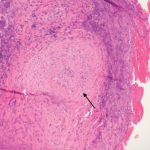Of course, the question will be empiric: The approach will either work, or it won’t, and a decade from now, we will be reading the editorials that expound on why we should have known how this story would play out.
In the meanwhile, one wonders what lessons this experience will have for our community. Decades ago, it was Anthony Fauci who appropriated cyclophosphamide from the oncologists, because he noted the sheets of inflammatory cells he saw in patients with GPA looked a lot like lymphoma.
In the next epoch, we can hope that genetic studies will lead to new targets and new approaches that will allow us to approach treatment based on the molecular, rather than clinical, phenotype. Already, genes have been identified that appear to play a crucial role in multiple forms of rheumatic disease.11 It’s hard not to wonder how many of those genes might be involved in those 20% of patients who appear to have refractory rheumatoid arthritis or refractory GPA and how many of them simply need a new approach. The identification of somatic mutations in our patients with refractory inflammatory diseases may demonstrate that they share more in common with each other than with the patients with whom they are currently grouped. Gene editing may provide yet another avenue for treatment of thus far untreatable inflammatory disorders.12
At the end of the day, the genetics underlying rheumatic disease will not be as simple as the genetics of eye color, hair color or even the ability to sing. The absence of a stronger familial component implies as much. But the absence of a recognizable melody doesn’t mean it’s not out there; it just means we have to listen a little harder.
 Philip Seo, MD, MHS, is an associate professor of medicine at the Johns Hopkins University School of Medicine, Baltimore. He is director of both the Johns Hopkins Vasculitis Center and the Johns Hopkins Rheumatology Fellowship Program.
Philip Seo, MD, MHS, is an associate professor of medicine at the Johns Hopkins University School of Medicine, Baltimore. He is director of both the Johns Hopkins Vasculitis Center and the Johns Hopkins Rheumatology Fellowship Program.
References
- Knight A, Sandin S, Askling J. Risks and relative risks of Wegener’s granulomatosis among close relatives of patients with the disease. Arthritis Rheum. 2008 Jan;58(1):302–307.
- Lyons PA, Rayner TF, Trivedi S, et al. Genetically distinct subsets within ANCA-associated vasculitis. N Engl J Med. 2012 Jul 19;367:214–223.
- Gonzalez-Gay MA, Rueda B, Vilchez JR, et al. Contribution of MHC class I region to genetic susceptibility for giant cell arteritis. Rheumatology (Oxford). 2007 Mar;46(3):431–434.
- Saruhan-Direskeneli G, Hughes T, Aksu K, et al. Identification of multiple genetic susceptibility loci in Takayasu arteritis. Am J Hum Genet. 2013 Aug 8;93(2):298–305.
- McGonagle D, Ayden SZ, Gul A, et al. ‘MHC-I-opathy’ unified concept for spondyloarthritis and Behcet disease. Nat Rev Rheumatol. 2015 Dec;11(12):731–740.
- Buch MH. Defining refractory rheumatoid arthritis. Ann Rheum Dis. 2018 Jul;77(7):966–969.
- Lemery S, Keegan P, Pazdur R. First FDA approval agnostic of cancer site—When a biomarker defines the Indication. New Engl J Med. 2018 Oct 12;377(15):1409–1412.
- Le DT, Durham JN, Smith KN, et al. Mismatch repair deficiency predicts response of solid tumors to PD-1 blockade. Science. 2017 Jul 28;357(6349):409–413.
- Garber K. Tissue-agnostic cancer drug pipeline grows, despite doubts. Nat Rev Drug Discov. 2018 Apr;17(4):227–229.
- Lopez-Mejias R, Carmona FD, Sastaneda S, et al. A genome-wide association study suggests the HLA Class II region as the major susceptibility locus for IgA vasculitis. Sci Rep. 2017 Jul 11;7(1):5088.
- Okada Y, Wu D, Trynka G, et al. Genetics of rheumatoid arthritis contributes to biology and drug discovery. Nature. 2014 Feb 20;406(7488):376–383.
- Ewart DT, Peterson EJ, Steer CJ. Gene editing for inflammatory disorders. Ann Rheum Dis. 2018 Aug 4. Epub ahead of print.



